Haryana State Board HBSE 9th Class Science Important Questions Chapter 6 Tissues Important Questions and Answers.
Haryana Board 9th Class Science Important Questions Chapter 6 Tissues
Very Short-Answer Type Questions
Question 1.
Are there same type of tissues in plants and animals?
Answer:
No, plants and animals have different types of tissues.
Question 2.
How are newly cells formed?
Answer:
Through cell division process.
Question 3.
What is called as unicellular organisms?
Answer:
All those organisms in which all the biological activities are fulfilled through single cell are called as unicellular organisms.
Question 4.
Which organisms undergo labour division?
Answer:
Multicellular organisms.
Question 5.
How many types of tissues are there in plants?
Answer:
Two types:
(i) Meristematic tissues
(ii) Permanent tissues.
Question 6.
Where are Meristematic cells found?
Answer:
Dividing cells (meristematic tissues) found at the tip of the shoot and at the tip of the root.
Question 7.
What is the function of meristematic tissue?
Answer:
Building up of new cells.
![]()
Question 8.
Do the permanent tissues have the ability of divide?
Answer:
No.
Question 9.
How many types of permanent plant tissues are there?
Answer:
Two types:
(i) Simple tissues
(ii) Complex tissues.
Question 10.
What are Parenchymatous tissues ?
Answer:
Parenchymatous tissues can be living and oval, rounded elongated or polygonal in shape. They have thin cell wall and the cells are isodiametric.
Question 11.
What are collenchymatous tissues ?
Answer:
Due to deposition of cellulose and Pectin at the angles of these tissues they get thinken in size. These tissues do not have intercellular spaces.
Question 12.
What are sclerenchymatous tissues ?
Answer:
These are dead cells. These cells do not have any intercellular space in them. They provide strength to the plant parts.
Question 13.
What are simple permanent tissues ?
Answer:
These tissues are formed of parenchymatous cells. Their origin, structural formation and function are same.
Question 14.
Which part of the plant consists of meristematic tissues ?
Answer:
Green part of the plant.
Question 15.
What are protective tissues made up of?
Answer:
By sclerenchymatous tissues.
Question 16.
Which parts of the plant consists of protective tissues.
Answer:
Leaves, flowers, stem and roots.
Question 17.
What is the other name of sclereids ?
Answer:
Brachysclereids or stone cells.
![]()
Question 18.
What is called as complex tissue ?
Answer:
Cells of different shape and size together form a group which works out a special function, is called as complex tissue.
Question 19.
How many types of complex tissues are there ?
Answer:
Two type:
(i) Phloem
(ii) Xylem.
Question 20.
Name the tissue that transports food in plants. [H.B.S.E. March, 2019]
Answer:
Sieve elements (phloem).
Question 21.
How many types of animal tissues are there ? Write their names.
Answer:
Four types:
(i) Epithelial tissues
(ii) Connective tissues
(iii) Muscular tissues
(iv) Nervous tissues.
Question 22.
Where are epithelial tissues found ?
Answer:
In the external and internal layers of animals.
Question 23.
Which tissue is called a protective covering in animals ?
Answer:
Epithelial tissue.
Question 24.
Which tissue is responsible for producing sperm and egg in animals ?
Answer:
Epithelial tissue.
Question 25.
What are the types of muscular tissues ?
Answer:
Three types:
(i) striated
(ii) unstriated
(iii) cardiac muscles.
![]()
Question 26.
Which muscles function according to owr will ?
Answer:
Voluntary muscles (Striated muscles).
Question 27.
Which type of muscles present in heart ?
Answer:
Cardiac muscles.
Question 28.
How many types of connective tissues are there ?
Answer:
Three.
Question 29.
Write two main functions of connective tissues ?
Answer:
Joining different organs and provide protection.
Question 30.
What are the types of skeletal connective tissues ?
Answer:
Two types:
(i) Bone
(ii) Cartilage.
Question 31.
Which tissue functions to connect bone to another bone?
Answer:
Ligaments.
Question 32.
What do tendons interconnect with?
Answer:
Muscle with bone.
Question 33.
Write down the name of the fluid tissue found in the body.
Answer:
Blood.
![]()
Question 34.
How many types of blood cells or corpuscles are found in blood?
Answer:
Three types of blood cells or corpuscles.
They are:
(i) Erythrocytes-Red Blood Cells (RBC)
(ii) Leucocytes: White Blood Cells (WBC) and
(iii) Blood Platelets.
Question 35.
What is the fluid part in blood called as ?
Answer:
Plasma.
Question 36.
What percentage of water is there in blood ?
Answer:
90%
Question 37.
Which tissues are brain, spinal cord and nerves formed of ?
Answer:
Nervous tissues.
Question 38.
What is nervous tissue called as ?
Answer:
Neuron.
Question 39.
What is the main function of neuron ?
Answer:
Sending impulses of messages.
Short-Answer Type Questions
Question 1.
Multicellular organisms are more superior in comparison of unicellular organisms. Why ?
Answer:
The unicellular organism can accomplish but a few functions and in doing that they are comparatively less expert to that of multicellular organisms. Among multicellular organisms by forming groups of lacs of cells not only those functions, rather they can perform more functions with complete skill, since they have the quality of labour-division in them.
Question 2.
Is there some difference between plants and animals tissues ?
Answer:
The plant tissues perform the function of supporting. Most of the tissues of plants are dead. The dead tissues too provide mechanical strength like the living tissues. They need little care of maintenance, where as the animals roam about here and there in search of companion, food and shelter. They consume more energy than plants. They possess maximum number of living tissues. Growth in some parts of the plants remains constrained, whereas in animals the case is different.
Question 3.
What are the different types of tissues found in plants ?
Answer:
Two types of tissues are found in plants:
(1) Meristematic tissues
(2) Permanent tissues

Question 4.
Write down the features of meristematic tissues.
Answer:
The features of meristematic tissues are as follows :
(1) Meristematic cells have same structure and their cell wall is thin.
(2) The shape of the cells is round, oval or polygonal.
(3) They are compactly arranged with each other and they don’t have any intercellular space in them.
(4) These cells have dense or sufficient cytoplasm (cell liquid) and a big nucleus.
(5) They have comparatively few vacuoles or no vacuole.
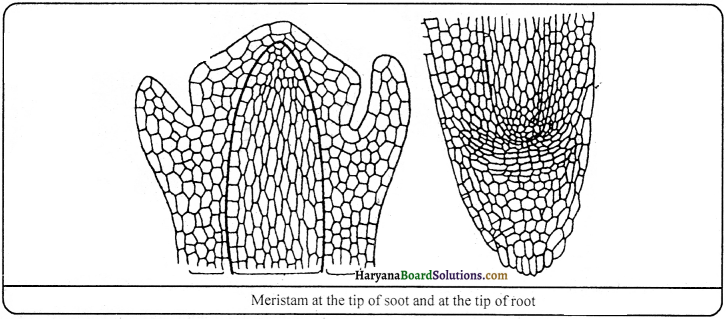
Question 5.
Where are meristematic tissues found in plants ?
Answer:
Meristematic tissues are found in the growing up parts of the plants only; Like-apical meristem and cambium (the region that increases thickness)
![]()
Question 6.
Write down the characteristics of permanent tissues.
Answer:
The characteristics of permanent tissues are as follows:
(1) Permanent tissues are formed of meristematic tissues.
(2) Their cells have no ability of division.
(3) They have a definite shapes.
(4) Their wall can be dead, thin or thick.
(5) They have enlarged cells and vacuolic cytoplasm.
Question 7.
Differentiate between meristematic tissue and permanent tissue.
Answer:
The difference between meristematic tissue and permanent tissue is as follows:
Meristematic Tissue:
1. They do not have intercellular space.
2. They have the ability of divide.
3. The are responsible for growth.
4. They are thin-walled and isodiametric.
5. They have an enlarged nucleus.
Permanent Tissue:
1. It can be or cannot be there in them.
2. They lack the ability of division.
3. They are no responsible for growth.
4. They are thin or thick-walled but not isodiametric.
5. They have small nucleus.
Question 8.
What are permanent tissues?
Answer:
Permanent tissues:
Permanent tissues are formed of meristematic tissues. Their tissues have no ability of division. Their size and volume is definite.
Permanent tissues are of two types:
(1) Simple tissues
(2) Complex or compound tissues.
Question 9.
Differentiate between parenchyma and collenchyma tissues.
Answer:
Following are the differences between parenchyma and collenchyma:
Parenchyma Tissue:
1. They are found in roots, stem and leaves.
2. Their walls are not thick.
3. They are formed of round and fine walled cells.
4. Their wall is made up of pectin and cellulose.
5. They helps in storing food and provide mechanical support.
6. They have intercellular space in them.
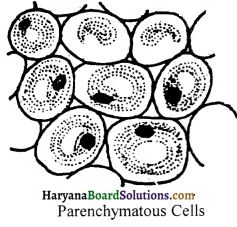
Collenchyma Tissue:
1. They are found in the middle vein of the stem and leaves.
2. Their walls are thick.
3. They have thick and elongated wall.
4. Their cell wall possesses collens of pectin.
5. They just provide mechanical support.
6. It is absent in them.

Question 10.
Enunciate different types of simple permanent tissues and write down the function of each. Answer: Simple permanent tissues are of three types :
(a) Parenchyma
(b) Collenchyma
(c) Sclerenchyma
(a) Functions of Parenchyma:
(i) Storing of food and assimilation.
(ii) To provide mechanical strength to the parts of plant.
(iii) Storing of resin, tanin, gum particles, and resin of morganie waste material.
(iv) Due to presence of chloroplast or chlorenchyma, they prepare food themselves.
(b) Functions of Collenchyma:
(i) They provide flexibility and strength to the plants.
(ii) Due to presence of chloroplast or chlorenchyma, they prepare glucose and starch.
(c) Functions of Sclerenchyma:
(i) They provide more strength to cartex and hard seeds.
(ii) They get transformed into protective tissues and protect the interior parts.
Question 11.
Differentiate among parenchyma, collenchyma and sclerenehyma.
Answer:
Parenchyma:
1. Their cell wall is constructed ot pectin and cellulose.
2. These are living cells.
3. Their function is food-storage and providing support.
4. They are found in root, stem and leaves.
5. They are formed of rounded thin walled cells.
Collenchyma :
1. Their cell wall is also formed of pectin and cellulose.
2. They too have living cells.
3. Their function is to provide mechanical support.
4. They are found in the middle vein of leaf and stem.
5. They are formed of multiarmed cells.
Sclerenchyma:
1. Their cell wall is formed of lignin.
2. Their cells are dead.
3. Their function is only to provide support
4. They are found in the stem and pulp of the fruits.
5. They are formed of thick-walled cells.
![]()
Question 12.
Describe Sclerenchvmatous tissue.
Answer:
Sclerenchyma:
These ceils are elongated in size and thin but are equipped with lignin. These are dead cells and are attached together. These cells are pointed at both ends. There is a clear mid lamella between adjacent cells. Cells consist of skewed regions that are called as pit canals. The cells provide strength to the parts of the plant.

Question 13.
Name different components found in Xylem (xylem tissues) components.
Answer:
The four components found in Xylem (xylem tissues) are as follows:
(1) Tracheids,
(2) Vessels,
(3) Xylem or wood Parenchyma
(4) Wood or Xylem fibers.
Question 14.
Give the importance of phloem in plants.
Answer:
Importance of Phloem: It is planted conductive tissue. It transports the starch (food) prepared by leaves to different parts of the plant.
Question 15.
Write functions of the Xylem (xylem tissues).
Answer:
Functions of Xylem:
It is too plant conductive tissue. It’s function is to transport the absorbed water and dissolved mineral salts by the roots to the leaves of the
plants and the apex. It also provide mechanical power to the plant.
Question 16.
Write short note on protective tissue.
Answer:
Protective Tissue:
Sclerenchyma found in the outermost parts of plants gets transformed into protective tissues. These tissues remain in the external layer of leaves, stems and roots. These tissues protect the interior tissues of plants. These tissues are covered with cutin. The cells of cork are dead. Cork is a lighter and protective tissue, it is more compressible and does not catch fire quickly.
![]()
Question 17.
What is stomata? Write its functions.
Answer:
Stomata:
They are found in the epidermal cells of the lower surface of leaves of plants which are called as stomatal pore. Stomata get protected by two guard cells.
Functions:
(1) Stomata are the nostrils of plants.
(2) Stomata plays a vital role in the exchange of gases and through them water loss takes place in plants.
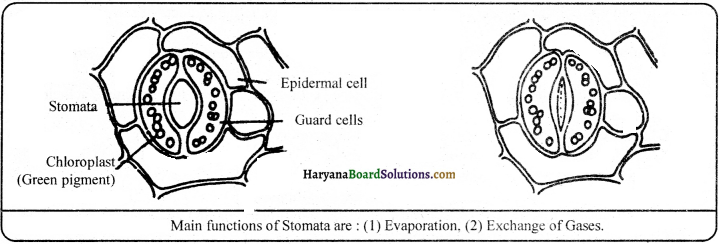
Question 18.
Write names of different tissues found in animals.
Answer:
Animal tissues:
There are four types of tissues found in animals.
(1) Epithelial tissue
(2) Connective tissue
(3) Muscular tissue
(4) Nervous tissue.
Question 19.
Give the names and important functions of animal tissues.
Answer:
Animal tissue:
(a) Epithelial tissues:
Functions: They participate in absorption, secretion, protection, excretion, etc.
(b) Connective tissue:
Functions: This tissue participates in interlink the various parts of the body, provide support, turgidity, storage, protection and transportation.
(c) Muscular tissue :
Functions: Muscular tissue participates in motion, conduction, contraction, etc.
(d) Nervous tissue:
Functions: These do the main work of controlling and management.
![]()
Question 20.
Write a typical note on epithelial tissue.
Answer:
This is a covering or outer protective tissue that cover the body of an animal. Also, it protects a number of organs and cavities inside the body. Skin, alimentary can be capillary tube’s coat, food pipe, hollow organs of lungs all are formed of epithelial tissues. There is very’ narrow space. In these tissues, the cells are compactly arranged.
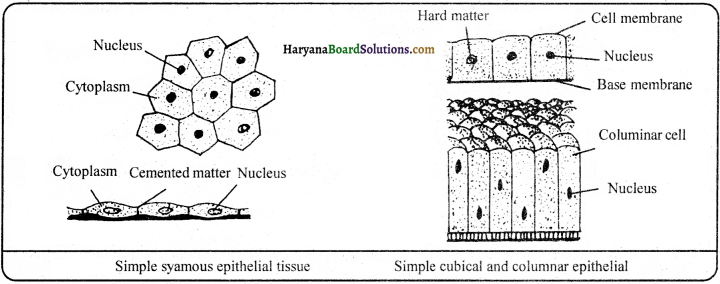
Question 21.
Classify Epithelial tissues.
Answer:
On the basis of shape and functions of the cells, epithelial tissues are classified into following types:
1. Squamous epithelium: These flat and disc like cells help in covering the organs of the body providing protection to them.
2. Cubical epithelium: These cubical or isodiametric cells are found in ducts of salivary glands and kidney tubules.
3. Columnar epithelium: The pillar or column like wide cells found in the layer of stomach and intestine.
4. Ciliated epithelium: Columnar and cubical shaped ceils germinate hair like structures at their ends that are called as cilia.
5. Glandular epithelium: These cells are found in secretory glands.
Question 22.
Write down the functions of Epithelial tissue.
Answer:
The functions of Epithelial tissue are the following :
(1) It performs the function to protect and cover the body organs
(2) It performs the functions of secretion, (in the Stomach and salivary glands)
(3) It produces sensitivity. (Eye and retinal cells)
(4) It produces sperm and egg.
(5) These absorb water and other salts.
(6) They also play role in excretion.
![]()
Question 23.
Write down the functions of connective tissue.
Answer:
The functions of connective tissues are as follows :
(1) These tissues join different organs of body with one another.
(2) They perform the function to tieup up organs of the body.
(3) These tissues give support to the organs of the body.
(4) Bone and cartilage build up the skeleton of the body.
(5) Adipose tissues store fat.
(6) These tissue perform the function of blood circulation.
(7) White blood corpuscles (WBC) fight against harmful bacteria.
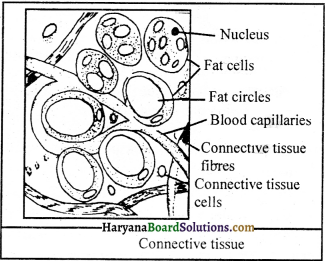
Question 24.
What is Blood?
Answer:
Blood:
Blood is a liquid connective tissue. It tissue drift in liquid plasma (matrix). Blood cells are callei
(i) Red blood corpuscles (RBC)-Erythrocytes
(ii) White blood corpuscles (WBC)-Leucocytes
(iii) Blood platelets
Blood runs in each part of the body and thus, it connects all the parts of the body.
![]()
Question 25.
What are the functions of blood ? Explain.
Answer:
Functions of Blood:
(1) Red blood corpuscles receive oxygen from lungs and send it to different parts of the body.
(2) Blood collects hormones from the hormone glands and sends it to different parts.
(3) It helps in excreting excretory products from the body.
(4) White blood corpuscles or leucocytes protects from harmful bacteria.
(5) Blood checks the body temperature.
(6) Blood platelets clots the blood and avoid the more discharge of blood out of the body.
Question 26.
What is Bone? What are its types ?
Answer:
Bone: Skeletal tissue is connective tissue. In this tissue, ’/3 part organic and 2/3 part inorganic material is found. Its matrix consists of a peculiar type of protein ‘ossein’ which is in the form of collagen fibres. Bone possesses matrix osteoblasts, cytus, fibers and matrix have calcium phosphate, calcium carbonate and calcium fluoride. It give strength to the bone.
Question 27.
What is compact bone ?
Answer:
Compact bone:
This bone used to be strong and hard. Inside the matrix of bone, calcium salts provide hardness to the bone. Compact bone is formed of round and irregular dense layers of bones. Compact bone is found in the long shaft of bones like-femur. It involves Haversian canals.
Question 28.
Write down two differences each between bone and cartilage.
Answer:
Following are the differences between bone and cartilage :
Bone Cartilage:
1. It’s matrix is hard and flexible.
2. It’s matrix is formed of condin.
3. It is covered with pericondrium.
4. Haversian system is absent in it.
bone:
1. It’s matrix is too rigid and strong.
2. It’s matrix is formed of ossein.
3. It is covered with peraosteium.
4. Haversian system is present in it.
![]()
Question 29.
Write down the difference between tendon and ligament. Answer: Following are the difference between tendon and ligament:
Tendon:
1. It is flexible and moulding.
2. It connects muscle with bone.
3. It is made up of yellow fibre.
Ligament:
1. it is inflexible and hard.
2. It connects bone with another bone.
3. It is made up of white fibred connective tissues.
Question 30.
Write down the functions of bone, cartilage tendon and ligament.
Answer:
(i) Bone : It constructs the structure of body and protects the soft orgAnswer:
(ii) Cartilage: It constructs the skeletons of cartilaginous fishes. In our body the tip of nose and external ear (pinna), is formed of it.
(iii) Tendon : It connects muscle with bone.
(iv) Ligament: It joins bone with another bone.
Question 31.
Write down the functions of skeletal tissue.
Answer:
Skeletal tissue: Skeletal tissue is rigid, there is sufficient quantity of calcium salts in bone-matrix. Following are the significant functions of skeletal tissue:
(1) Skeletal tissue enshapes the body.
(2) Skeletal tissue protect the sensitive organs of the body.
(3) Skeletal tissue helps in joining muscles together.
(4) This tissue provides movement and locomotion to the body.
(5) In the middle of the bones erythrocytes (RBC) are produced.
(6) It provides surface for attachment of muscles (tendons and ligaments).
Question 32.
What is areolar tissue?
Answer:
Areolar tissue:
This tissue is found below the skin, between the muscles, blood vessels and around the nervous tissue. These cells possess jelly types transparent and sticky matrix. This is connective tissue. It interlinks body cavity and other parts of the body.
Question 33.
What is muscular tissue ? What are its types ?
Answer:
Muscular tissue:
The cells of these tissues are elongated, spindle shaped and unbranched. Cardiac muscles are branched. Muscular tissues are found in different sizes. Muscular tissues provide locomotion and movement to different parts of body.
Muscular tissues are of three types :
(a) Striated muscles. (Skeletal or voluntary muscles)
(b) Unstriated muscles. (Smooth muscles or involuntary muscles)
(c) Cardiac muscles.
![]()
Question 34.
Make difference between striated muscles arid cardiac muscies.
Answer:
The differences between striated muscies and cardiac muscles are as follows:
Striated muscle:
1. These muscles work accordingly to our will i.e., they are voluntary muscles.
2. These muscles are jointed with bones.
3. They are unbranched.
4. They have a number of nuclei.
5. They have light or dark bands on them.
Cardiac muscle:
1. These muscles are involuntary, they do not work accordingly to our command.
2. These muscles are found in the heart.
3. They are branched.
4. They have one or two nuclei.
5. They have transverse indistinct light bands which show faint cross striations.
Question 35.
Describe the structure of skeletal and cardiac muscles.
Answer:
Skeletal Muscles:
We can move some muscles by the conscious will. Muscles present in our limbs move when we want them to, and stop when we so decide. Such muscles are called voluntary muscles. These muscles are also called skeletal muscles as they are mostly attached to bones and help in body movement. Under the microscope, these muscles show alternative light and dark bands or striations when stained appropriately. As a result, they are also called striated muscles. The cells of this tissue are long, cylindrical, unbranched and multinucleate (having many nuclei).
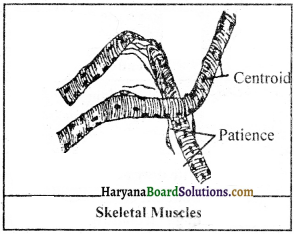
Cardiac Muscles: The muscles of the heart show rhythmic contraction and relaxation throughout life. These involuntary muscles are called cardiac muscles. Heart muscle cells are cylindrical, branched and uninucleate.

Essay Type Questions
Question 1.
What is called a tissue ? How many types of plant cells are there ? Describe meristematic tissues.
Answer:
Tissue:
A group of several cells that have common origin, structure and function is called a tissue. In plants there are two types of tissues.
(i) Meristematic tissues
(ii) Permanent tissues.
Meristematic Tissue:
In these tissues, division of cells takes places continuously and these cells that have the ability to divide, they keep on reproducing newly cells. Meristematic tissues are found only in those parts that participate in the growth process like tip of the shoot-root, and cambium. Due to these tissues, the length and thickness of the plants get increased.
On the basis of origination, meristematic tissues are of two types:
(i) Primary meristematic tissues.
(ii) Secondary meristematic tissues.
On the basis of position meristematic tissues are of three types:
(a) Apical meristem: They are found at the tip of the root, stem and branches; They are also of three types:
(1) Epidermis: These tissues buiid up the outer skin of the plant.
(2) Cortex: These tissues buiid up the filling up system.
(3) Hypodermis: These tissues make transport tissues, phioem and xylem,
(b) Intercalary meristem: This tissue is found in the stem of monocotyledones. Due to activity of this tissue plant grow up in height.
(c) Lateral meristem: This tissue is found in the stems and root of dicotyledones.
![]()
Question 2.
How many types of simple tissue of plant are there ? Explain them.
Answer:
Simple tissue When the meristematic tissues totally lose the ability of division, then they transform into permanent tissues. Permanent tissues are of two types: Simple tissues and complex tissues. Simple tissues are formed of only one type of same structural cells. Their function is also same. On the basis of structure these tissues are of three types:
(i) Parenchyma:
These tissues are found in the shoot system (stem, leaves and flower) and root in plants. In the green part of the plant their number used to be more. These cells can be round, elongated or polygonal shape. These are living cells. Their cell wall is thin and is made up of cellulose. These cells contain dense protoplasm. The main functions of these tissues are storage of food, assimilation, provide strength, storing of resin tanin and gum and many times preparing food too.
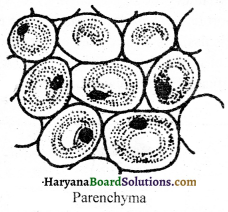
(ii) Collenchyma:
These cells too are living. These are multiarmed, oval and rounded shaped. Their cell wall is thin, but at the corners of the cell due to deposition of cellulose and pectin they get hard or stout. In these cells generally there are some chloroplasts. This tissue brings flexibility and strength in plants and prepare glucose and starch due to presence of chloroplast in it.
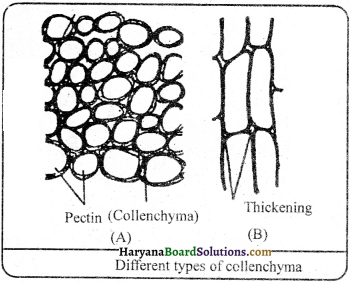
(iii) Sclerenchyma:
These cells are elongated in size and thin but are equipped with lignin. These are dead cells and are attached together. These cells are pointed at both ends. There is a clear mid lamella between adjacent ceils. Cells consist of askewed regions that are called as pit canals. The cells provide strength to the parts of plant.
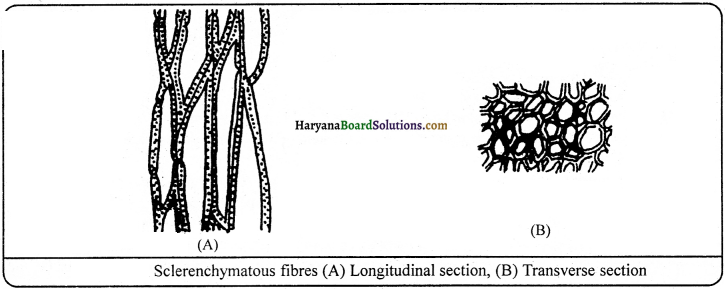
Question 3.
What is called as complex tissues ? What are their types in plants ? Explain each of them.
Answer:
Complex Tissue:
Complex tissue is a group of more than one type of cells which perform a special function. Complex tissue is of two types :
(1) Xylem: Xylem is a transport tissue. It transports water and dissolved mineral salts from root to the shoot-system. All the cells of this tissue are dead, thick walled and lignified. This tissue is formed of with the combination of four cells.
(i) Trachieds
(ii) vessels
(iii) xylem or wood-parenchyma
(iv) xylem fibres.
![]()
(2) Phloem:
It is a living transport tissue. Starch prepared due to photosynthesis process is transported to different parts of the plant by it. This tissue is also formed of with the combination of four components :
(i) Sieve tubes
(ii) companion cells
(iii) phloem parenchyma
(iv) phloem fibres.
Out of these sieve tubes are significant. These sieve tubes consist of porous wall that send food from the leaves to different parts of the plant.
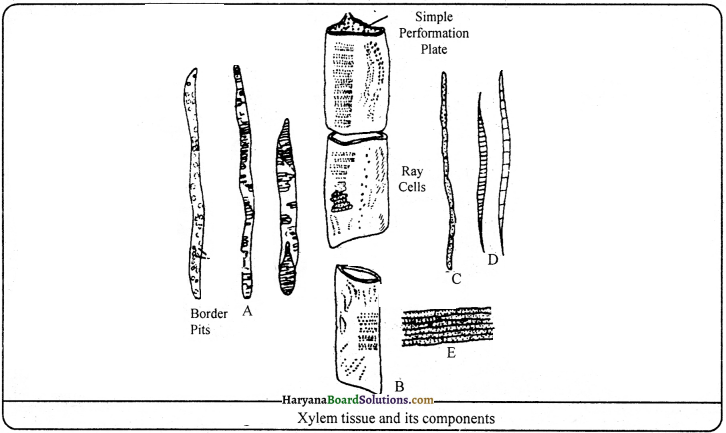
Question 4.
What is called as nervous tissue ? How many types does it have ?
Or
Define the neuron with diagram.
Answer:
Nerve cells (neurons): It is a specialised elongated cell which is the basic unit of conduction of impulses Tn this cell there a nucleus surrounded with cytoplasm. Many small branches project out of cytoplasm, which are called as dendrites. One of these branches is the longest one which is called as Axon. Axon carries the impulses away from cells. One nerve cell does not directly join with the another neuron. They have some empty space between them in which there is a very closed transportation. It is called as synapses.
![]()
If we have pain in our hand, this information gets collected by the dentrites of the sensory neuron located in the hand. The sensory neuron converts it into electric signal. This signal is transmitted by the motor neurons and passing through synapse reaches the brain. The brain on receiving the impulse reacts to that. The motor nerve carries this reaction to the muscles of the hand and thus, the muscles of the hand make suitable reaction.
Thus, nerve cells (neurons) are of three types:
1. Sensory nerve cells (neurons): They carry sensations in different parts of the body towards brain.
2. Motor neurons: These receive message from the brain and further send it to the muscles.
3. Multipolar neurons: They does both the functions they carry sensations towards brain and further carry the commands of brain towards the muscles.
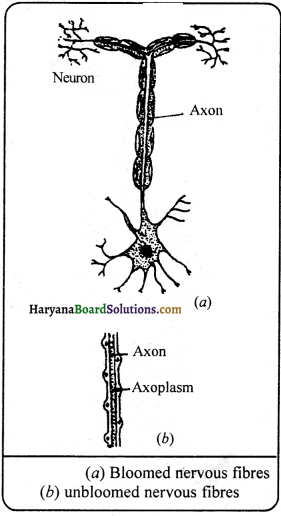
Question 5.
What is blood (human blood) ? Explain its constituents.
Answer:
Blood: Blood is liquid connective tissue which is red in colour. Blood circulates in the organs of body, thus it can be said that it connects the entire parts of the body together.
Human blood has mainly two constituents:
(A) Plasma: This is a substance in the blood which is light yellow in colour. It contains 90% of water. The remaining salts, glucose, amino acid, protein, hormone, oxygen, carbon dioxide gas and certain digested undigested food materials are also found in it.
Function: It consists of fibrin named protein, that helps in coagulation or clotting of blood. It also consists anti bodies which destroy foreign bodies harmful bacteria etc.
(B) Blood corpuscles (Blood cells): There are three types of corpuscles found in blood which are described as ahead:
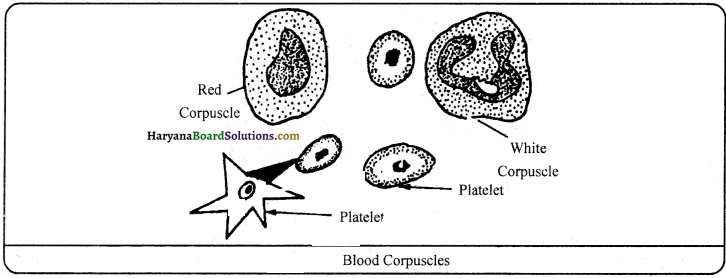
(a) Red Blood Corpuscles or Erythrocytes: These are round in shape. Each red corpuscle has the life time of nearly four months. They have a substance namely haemoglobin in them which provides red colour to blood. They are round in shape, flat and small in size. They have no nucleus in them. They have the largest number (50 lakh oer cubic milliletre).
![]()
Functions:
(i) Red blood corpuscles provide red colour to the blood.
(ii) Their haemoglobin distributes oxygen throughout the body. On receiving oxygen these corpuscles i become oxy-haemoglobin.
(b) White Blood corpuscles or Leucocytes : The number of white blood corpuscles is lesser than red blood corpuscles, but they are bigger in size than them. They are white in colour, since they have no haemoglobin in them. Therefore they do not have a definite shape. They also have nucleus. They are of five types.
Function: They kill the harmful bacteria in the body and gobble them up. Thus, they protect us from diseases.
(c) Thrombocytes or Platelets: They are thick in the centre and thin at the ends. They are very small. They also have nucleus.
Function: They help in coagulation of blood. When in case of injury, blood oozes out from the wound, these platelets gather around the injury and by a chemical action clot there, so that there might not be any more bleeding.
Practical Work
Experiment-1:
Observing the structure of stem by cutting it in a transverse section (T.S.).
Procedure:
(i) Peel off a thin slice or transverse section of a thin and soft stem of a plant, keep it into the safranine solution.
(ii) Take a slice of stem section and keep it on a glass slide carefully leave a drop of glycerine on it and cover it with a coverslip.
(iii) Observe the prepared slide under the compound microscope and draw a sketch diagram of the setting up of the cells that you observe.
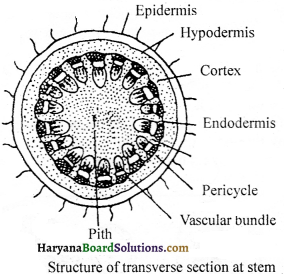
Quick Review of the Chapter
1. Blood transports
(A) oxygen
(B) food
(C) harmones and waste substances
(D) all of the above
Answer:
(D) all of the above
2. Nearly all tissues of are dead.
(A) plants
(B) animals
(C) both (A) and (B)
(D) saprophytes
Answer:
(A) plants
3. New cells in plants are formed by tissues.
(A) parenchyma
(B) collenchyma
(C) meristematic
(D) sclerenchyma
Answer:
(C) meristematic
![]()
4. Which of the follow ing is not the characteristic of meristematic?
(A) highly active
(B) more cytoplasm
(C) vacuole present
(D) distinct nucleus
Answer:
(C) vacuole present
5 tissues are found in the growing up parts of root and stem.
(A) Parenchyma
(B) Meristematic
(C) Sclerenchyma
(D) Collenchyma
Answer:
(B) Meristematic
6. The helpful tissue in photosynthesis is :
(A) parenchyma
(B)
(C) sclerenchyma
(D)
Answer:
(A) parenchyma
7 tissues carries the function of storage.
(A) collenchyma
(B)
(C) sclerenchyma
(D)
Answer:
(B) parenchyma
8. The tissues which makes a plant hard and strong is :
(A) collenchyma
(C) parenchyma
Answer:
(B) sclerenchyma
9. Which tissues make up the husk of coconut ?
(A) sclerenchyma
(C) parenchyma
Answer:
(A) sclerenchyma
10. Sclerenchyma is found in the of a plant.
(A) stem
(B) near vascular bundle
(C) buds of leaves and seeds
(D) all of the above
Answer:
(D) all of the above
![]()
11. Holes/pores are found :
(A) on the surface of leaf
(B) in vessels
(C) in xylem
(D) in phloem
Answer:
(A) on the surface of leaf
12. Which of the following is not a function of epidermis ?
(A) reduces the loss of water
(B) protects from mechanical shocks against water cell
(C) helpful in entry of parasite fungi
(D) all of the above
Answer:
(C) helpful in entry of parasite fungi
13. The shape of protective cells/tissues in stomata is
(A) like liver
(B) like kidney
(C) like the seed of bean
(D) like the seed of gram
Answer:
(B) like kidney
14. The function of stomata is:
(A) evaporation
(B) intake and release of oxygen
(C) intake and release of carbon dioxide
(D) all of the above
Answer:
(D) all of the above
15. The capacity of water absorption in roots increases by:
(A) increase in the size of root
(B) increase in the length of root
(C) due to hair roots present on roots
(D) all of the above
Answer:
(C) due to hair roots present on roots
16. What makes bark impermeable for air and water ?
(A) waxy cover
(B) thick layer of bark
(C) chemical named subrin
(D) all of the above
Answer:
(C) chemical named subrin
17. The example of complex tissue is:
(A) xylem
(B) meristematic
(C) phloem
(D) both (A) and (C)
Answer:
(D) both (A) and (C)
![]()
18. ………….. is Conductive tissue.
(A) xylem
(B) phloem
(C) both (A) and (B)
(D) neither (A) nor (B)
Answer: (C) both (A) and (B)
19. The parts of xylem are:
(A) tracheids
(B) vessels
(C) xylem parenchyma and fibre
(D) all of the above
Answer:
(D) all of the above
20. The parts of phloem are:
(A) sieve tubes
(B) companion cells
(C) phloem parenchyma and fibres
(D) all of the above
Answer:
(D) all of the above
21. Minerals and water are transported by:
(A) phloem
(B) xylem
(C) sieve tube
(D) companion cells
Answer:
(B) xylem
22. Phloem conducts:
(A) synthesised food
(B) mineral salts
(C) water
(D) all of the above
Answer:
(A) synthesised food
23. Which tissue is not a simple tissue?
(A) sclerenchyma
(B) phloem
(C) parenchyma
(D) collenchyma
Answer:
(B) phloem
24. Which tissue is not an animal tissue?
(A) epithelial
(B) epidermal
(C) connective
(D) muscular
Answer:
(B) epidermal
25. Which tissue carries the function of covering the body and making covers for different organs inside the body?
(A) epithelium
(B) connective
(C) nervous
(D) muscular
Answer:
(A) epithelium
![]()
26. Which one is not a type of epithelium tissues?
(A) squamous
(B) cubical
(C) rounded
(D) columnar and ciliated
Answer:
(C) rounded
27. Which tissue forms the difference of alimentary canal and mouth?
(A) glandular
(B) squamous
(C) columnar
(D) cubical
Answer:
(B) squamous
28. What kind of tissue is blood?
(A) epithelium
(B) connective
(C) muscular
(D) nervous
Answer:
(B) connective
29. Which blood cells carries the function of intake of oxygen?
(A) RBC
(B) WBC
(C) platelets
(D) all of the above
Answer:
(A) RBC
30. Bone is an example of what type of tissue?
(A) epithelium
(B) connective
(C) muscular
(D) nervous
Answer:
(B) connective
31. The tissue which provides motion to body is:
(A) epithelium
(B) connective
(C) muscular
(D) all of the above
Answer:
(C) muscular
32. The feature of voluntary muscle is:
(A) long in size
(B) cylindrical
(C) unstriated
(D) all of the above
Answer:
(D) all of the above
33. Involuntary muscles are not found in:
(A) bones
(B) eyelids
(C) urinal
(D) trachea of lungs
Answer:
(A) bones
![]()
34. Which cell can be longest?
(A) epithelium
(B) nervous
(C) connective
(D) muscular
Answer:
(B) nervous
35. Which tissue rs found in heart?
(A) muscular
(B) nervous
(C) epithelium
(D) connective
Answer:
(A) muscular